We have studied the opening sequence of Pan’s Labyrinth and have picked out the different key elements of film form in it, going into detail about how each one has been done to covey information or meaning to the audience.
Cinematography: The sequence starts off with a unique camera movement. The camera crabs to the left to show Ofelia bleeding, then twists right to make her lying eye-level with the camera and therefore the audience. This puts them in the environment of the scene, which is made cool and dull by the silvery and grey colour palette used here, and also focuses all attention on Ofelia, signifying her importance, and that this scene must hold significant importance in the course of the narrative. It also puts the camera in position to push into Ofelia’s eye, and a fast and CGI transition into the underworld kingdom implies a change in place and time-period, also creating a sense of fantasy and mystical nature. once we have entered the kingdom, the camera pans left to cover an extreme wide-shot of the kingdom. This shows the audience how huge and seemingly powerful and grand it all is. It also provides the mise-en-scen, which I will go into later, plenty of space to be put on display.
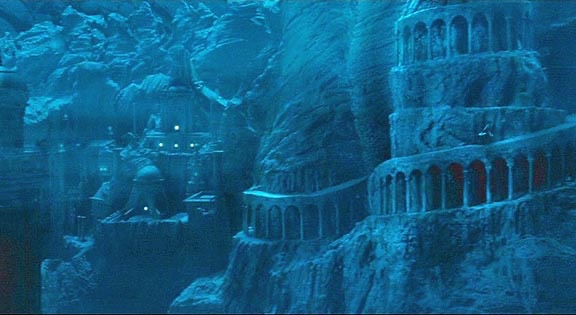
The camera then pushes in to bring our attention to Moana and her escape, and then tilts upwards to reveal the huge staircase, keep Montana at the forefront of the audiences attention, and also allows for the soundtrack to build up to the blinding light that follows. here the screen is over-exposed to put the audience in Moana’s position, blinded and shocked by an intense light. it also makes for another smooth and seamless transition into the upper-world, which has a different colour palette to show a different place, temperature and once again, time-period. the camera then slowly crabs right to let the new setting sink in whilst the narrator continues, and also so a skeleton can be revealed, making it clear that violence will be prevalent in the film, and also establishing the conflict that is the backdrop of the Spanish Civil War. It then floats up to bring to our attention the cars driving past, and the abandoned church and mass-expanse of woodland.
We then see a close-up of Ofelia’s fairy-tale book, which signals that it is important to her, shows an illustration that hints at Ofelia’s state later on in the film, and shows that fairy-tales and fantasy elements are also going to be a present theme in the film. there are multiple over-the-shoulder and two-shots in the car to show Ofelia’s conversation with her mother. As Ofelia walks around the woods, the camera drops to her level, putting the audience, once again, in her situation, and also showing that she is the centre of the films focus. Even the tilt to the sky mimics where she is looking. The focus on the stone on the floor establishes it as an object of significance, and also Ofelia’s noticing of it. We then cut to a close-up of Ofelia’s face to see that she has noticed something that has caught her attention, bringing in the audience as this captures their attention.
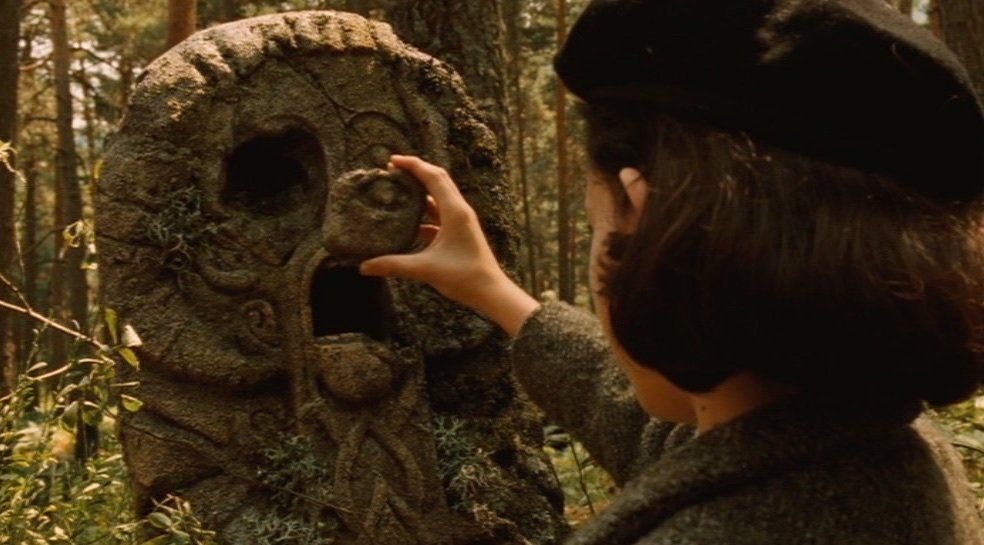
There is an match-on-action to bring our attention on Ofelia picking up the rock, then a close-up to display the unusual formation on it. The over the shot of Ofelia and the statue also makes it look as if the statue is a character itself, contributing to the mystery and suspense of the whole scene. The camera slowly pushes in on the mouth of the altar to ensure that the audiences tension is on it, this way making sure that they have some reaction to the bug that crawls out of it. An over-the-shoulder shot shows Ofelia’s reaction to it. The way that the camera follows the bug also shows Ofelia’s perspective.
The camera follows the insect as it flys away, but keeps Ofelia in shot and the her as the object as focus, this is to show her delight as she looks at the fairy, and remind the audience that the insect is important in relation to her, as she is the protagonist. The insect only leaves frame when Ofelia’s mother enters it, and puts her and the officer in focus to show that this trance that Ofelia was in whilst looking at the insect has been broken to an extent. As the insect/fairy crawls around the trunk of the tree the camera lowers and arcs to follow it and imply to the audience that it is certainly following the truck and cars.
The close-up on Vidal’s watch signifies it significance to him, much like the earlier shot of Ofelia’s book, how it is shown even before them. The close-up also brings attention to how there is a crack on the watch, making the audience wonder why that is there. There is then a close-up on his face to show his importance as a character, and then the camera pans right to follow the cars and reveal the mill and setting of the film to the audience, an establishing shot.
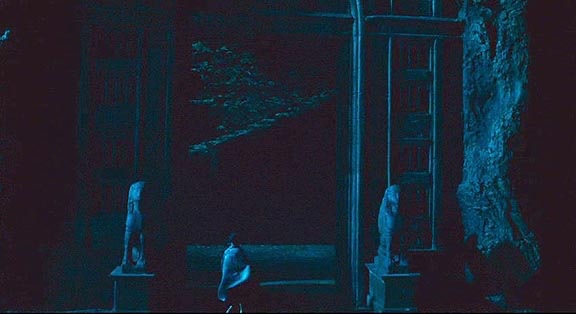
Sound:
The silence included in the opening credits build suspense, and then the diegetic sound of wind and an owl hooting establishes an atmosphere that’s is cold and outside. The lullaby is used as a motif to create suspense and put the audience on edge as it and the wind gradually rise in the mix, which by now is layered due to the different sounds of the woods and Ofelia’s breathing and Mercedes’ humming, slowly bringing the audience into the scene before we even see anything.
the breathing also adds to the tension, making the audience wonder why it is there. A windy swooshing noise is played during the transition to the underworld, making it feel cold and subtly hinting at a change in atmosphere, and matching the speed of the camera, making it feel more like we are actually there, in the scene. The crows cawing adds a dark undertone to the sound mix, as the birds are traditionally associated with themes of death, like a dark foreshadowing, and reference to the pervious shot of Ofelia dying.
The swooshing sound and the crows cawing again signals a change in atmosphere, and hints at the theme of death that is about to be shown in the form of a rotting skeleton. The score has a choral quality to it, establishing the old time-period and eerie atmosphere. The non-diegetic score stops when the conversation starts to keep our attention on it. The sound of the car braking is quick and sharp, showing that there has been a stop and also that the drivers are likely efficient. The diegetic sounds of the cars and people fades away as Ofelia walks off, putting us in her position and distracted mindset.
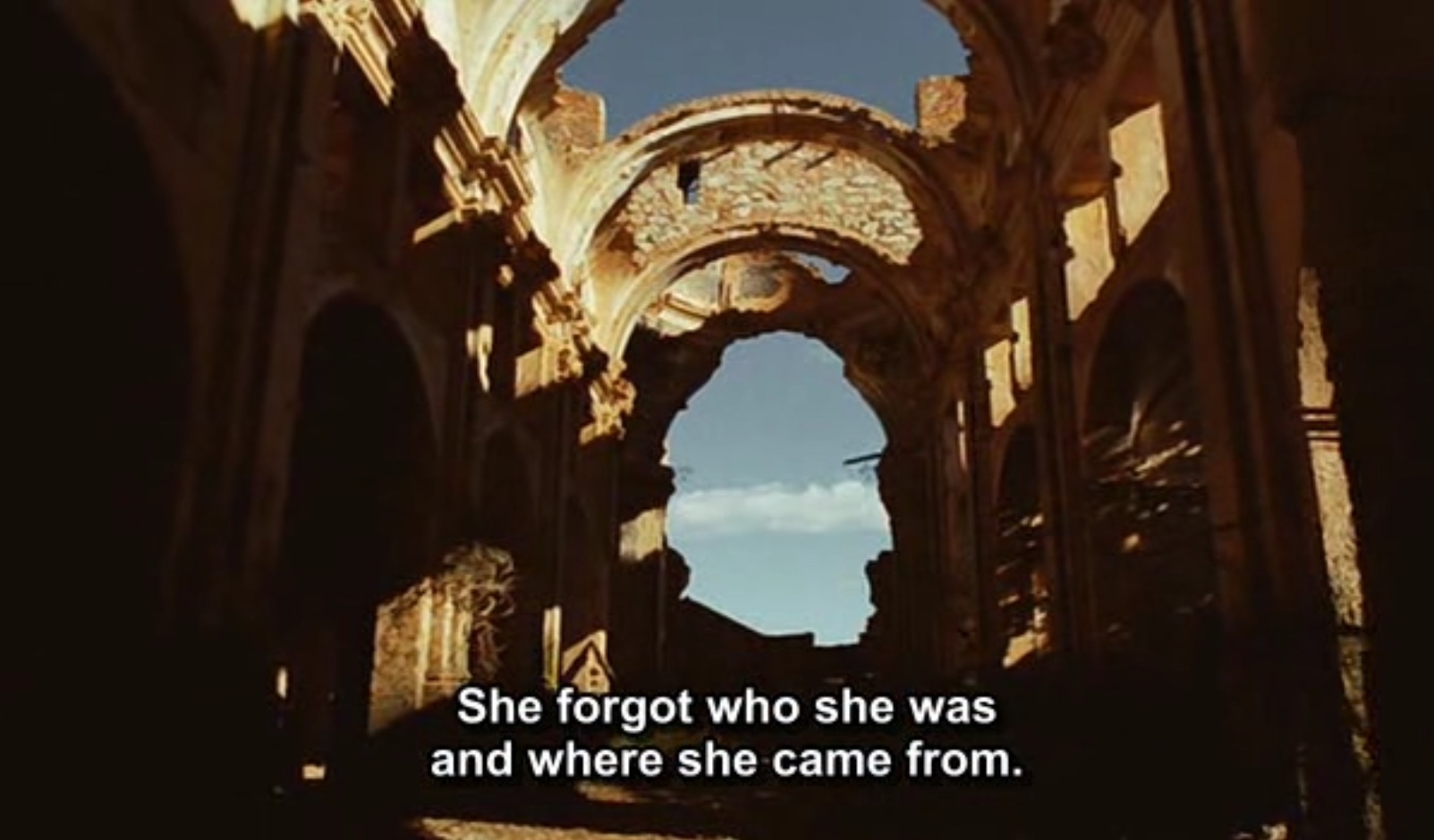
As Ofelia picks up the stone, the non-diegetic score picks up again, in-concisely making a link in the audiences mind between the underworld and the rock. The sound stops as the camera pushes into the mouth on the stone, helping to build tension and keep the audience as attention on the stone, not the music. The sounds of the insect are quick and clicks, which are uncomfortable to listen to, and these stop as Ofelia’s mother calls to her, breaking the trance made by the focus on the insect. When we see Vidal’s watch, we hear the rhythmic clicking of it, implying that the captain has a close eye on time and orderliness.
Editing:
The captions are edited in to allow English audiences to understand what is being said. The scene where Ofelia is bleeding out is also played in revere, showing that this scene takes place at the end of the film and also gives the scene an unreal and fantastical element.The transition to the underworld is done without making any cuts, since it pushes into her eye and then we discover that there has been a change in environment. This is done to make the flow between places and time periods seem fluid and even in-noticeable. The character of Moana also seems to be edited in, making her movement seem flowing and dream-like. The scene in the underworld is one long and continuous cut that makes the sequence feel like a dream, and the way that it is constantly moving forward makes it feel like the words on the page of a book, which, of course, it is.
The transition to the upper-world is also done without cutting, instead through a flash of blinding light. The only cut we notice fades in as the camera passes a wall, and is hard to notice at first. The scene only cuts when Ofelia reaches the end of the fairy-tale. As Ofelia walks through the woods, the camera follows her and the scene does not cut for a few moments. This lets the atmosphere and setting of the woods sink in, and also keeps the audiences attention as we approach the rock on the ground. When the scene cuts to Captain Vidal at the mill, it is a J-cut since we hear the ticking of the watch before we see it, and this lets the audience know beforehand that something of significance is about to be shown.

Mise-en-scen:
The blood dripping from Ofelia’s nose signals to the audience that she is dying, as-well as that blood on her hand. The architecture in the Nader world kingdom is large and ancient and grand, implying that it is old and powerful, and it also creates the feel of a place from a fairy-tale. The statues shown near the stairs are very similar to those of ancient Egyptian art, which establishes the inspiration for the kingdoms design, and also the pillars are similar to those of Ancient Rome. The immediate debris and destruction that we see on the surface immediately shows the destruction and chaos of the war. So does the rotting skeletons, which also links back to what the narrator is saying about Moana’s death when she reached the surface world.
One of the skeletons also has a pair of glasses next to it, a clear foreshadow of the doctors death later on in the film. The Cars are Rolls-Royce’s which shows that the army has a clear budget to spend, and so are Ofelia and her mothers’ clothiers, showing that they are likely from the city. Even the book is designed to look like an old, antique fairy-tale book.

The design of the stone creates a sense of mystery and attracts the audiences interest, and then when it fits into the rock, we see that the rock has a similar design to those buildings in the under world, establishing a link between them. The design of the bug is intricate, sharp and deadly-looking, creating a feeling of repulsion to it in the audience. The guns that the soldiers are holding signal that Ofelia and her mother are extremely important to them ands have reason to be protected, and also hints at the later conflict in the film.
The vast amount of boxes and crates at the mill show that the Nationalists are powerful, have budget to spend, and are planning on setting up a permanent base/stronghold at this clearing, as well as the huge amounts of soldiers. The uniform of the captain is intricate, flashy due to its medallions and badges, and how tidy it is, all signalling, along with the watch, that he is an important figure in the film.
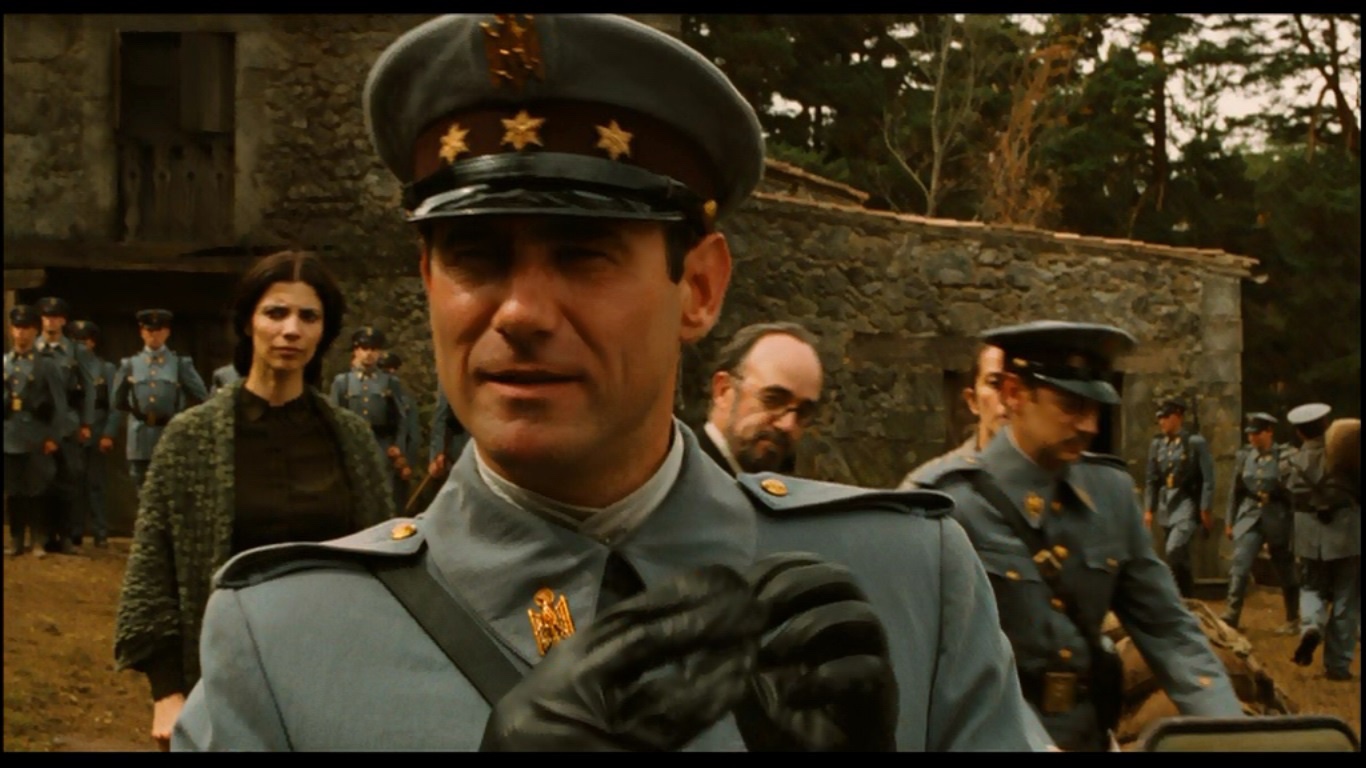
Performance:
The laboured breathing and distressed expression on Ofelia’s face shows that she is scared and injured, and this captures the interest and sympathy of the audience. Her mother comes across as loving and protective of her daughter, but still confused at her obsession with fairy-tales. She is also clearly sick with her sniffling, tired face, exhausted demeanour and sickly coughing. On the other hand, Ofelia seems interested and curious, calm at her mothers coughing. This implies that she is fearless and follows her curiosity, as seen with how she investigates the altar and is ecstatic at the insect. The captain is cold, clearly frustrated with the late arrival of the cars, and commands an air of authority with his silence and in-flinching stare.
You must be logged in to post a comment.